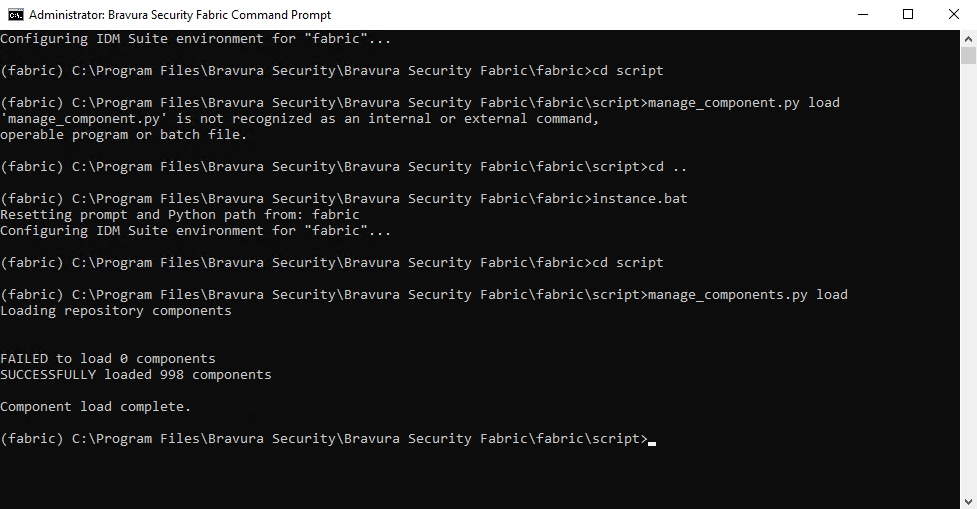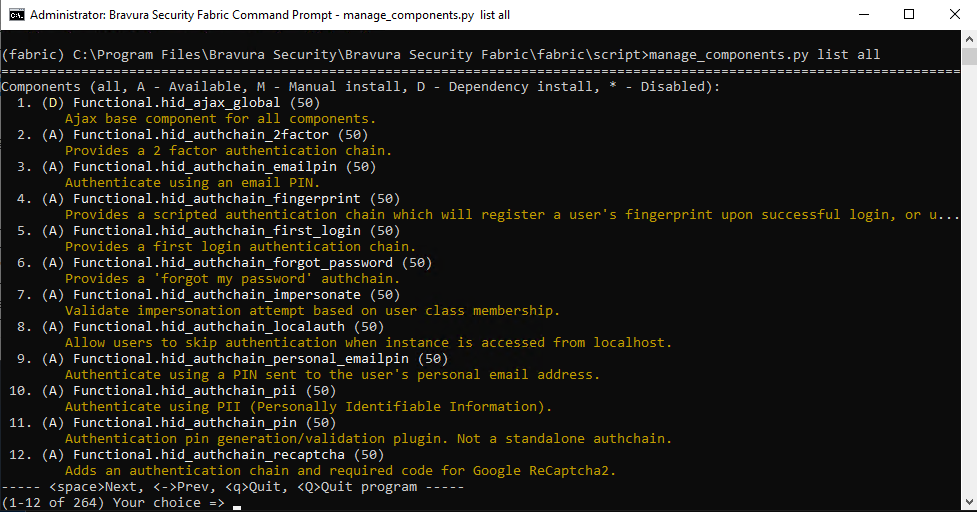Managing components from the command line
This section shows you how to manage components from the command line using the manage_components.py script.
Setting up the component management command-line program
The component management program (manage_components.py) is a Python executable script located in the <Program Files path>\Bravura Security\Bravura Security Fabric\<instance>\ script\ directory. To run it from the command line, you may need to configure a number of environment variables:
Launch a command prompt as an Administrator and navigate to the <Program Files path>\Bravura Security\Bravura Security Fabric\<instance>\ directory.
Run the command:
instance.bat
Navigate to the script directory.
You should now be able to run the component management program. Ensure that you always run it as an Administrator.
Loading from the command line
To load the list of available components from the command line:
Launch a command prompt as an Administrator and navigate to the script directory, as described in Setting up the component management command-line program .
Run the command:
manage_components.py load

Listing from the command line
To list all components from the command line:
Launch a command prompt as an Administrator and navigate to the script directory, as described in Setting up the component management command-line program.
Run the command:
manage_components.py list all
Navigate through the list using space and - keys.
You should see a list of all the components available to you with a status marker to the left of the name.

To filter the list, type any part of the component name or description; for example, type wizard to list only components whose names include the string wizard.
The status markers have the following meaning:
| Available |
| Manual install |
| Dependency install |
| Disabled |
Installing from the command line
Unlike using the web interface, using the manage_components.py script from the command line allows you to install data components, such as a component that contains data for a profile attribute.
Click below to view a demonstration.
To install a component from the command line:
Launch a command prompt as an Administrator and navigate to the script directory, as described in Setting up the component management command-line program .
List components as described in Listing from the command line .
You can shorten the list by typing part of the component name to search for.
Type the number of the component you want to install.
Type:
install
The component management program installs the component along with its dependencies. You should see its status change to an
Mon the listing page.
Alternatively, if you know the name of the component, you can type the command:
manage_components.py install <component_name>
Removing from the command line
Components can only be removed if they have the removable flag in their manifest.xml file set to ”true”.
To remove a component from the command line:
Launch a command prompt as an Administrator and navigate to the script directory, as described in Setting up the component management command-line program .
List components as described in Listing from the command line .
Type the number of the component you want to remove.
Type:
remove
Alternatively, if you know the name of the component, you can type the command:
manage_components.py remove <component_name>
Only the specified component will be removed. You must remove each of its dependencies individually. Components that were installed as a result of being a dependency will have a status of D.
Enabling or disabling from the command line
Disabling a component prevents any scripts associated with that from executing. If you cannot remove a component, it is recommended that you disable the component instead.
Take care when disabling dependency components; other installed components may also rely on them.
To enable or disable a component from the command line:
Launch a command prompt as an Administrator and navigate to the script directory, as described in Setting up the component management command-line program .
List components as described in Listing from the command line .
Type the number of the component you want to enable or disable.
To enable a component type:
enable
or
To disable a component type:
disable
Working on multiple components at the same time
The install, remove, enable, disable options can take a list of components; for example:
manage_components.py install <component_name_1> ... <component_name_n>
The above command attempts to perform the install action on all components listed in the command. If an action fails, manage_components.py outputs an error message but continues to the next item.
Additional information
One advantage of using the manage_component.py program to manage components is that it allows the installation of Data components; for instance, a profile attribute:
manage_components.py install Data.hid_attribute_personal_email
When working with custom components, it is often required to refresh the component database; for instance, after creating a new component:
manage_components.py load
If installed components contain a UI element, you can use the --patch parameter with manage_components.py to reload the component database and rebuild the skins simultaneously.
manage_components.py load --patch